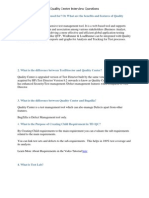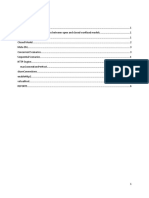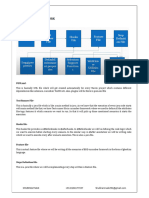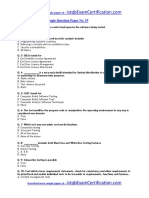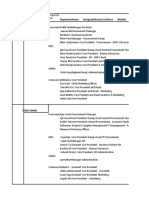SDLC
SDLC
Uploaded by
Dada DildadaCopyright:
Available Formats
SDLC
SDLC
Uploaded by
Dada DildadaOriginal Title
Copyright
Available Formats
Share this document
Did you find this document useful?
Is this content inappropriate?
Copyright:
Available Formats
SDLC
SDLC
Uploaded by
Dada DildadaCopyright:
Available Formats
Why sdlc important to deve lop software?
Answers:
Because software can be very difficult and complex. We need the SDLC as a framework to guide the development to make it more systematic and efficient. We will be able to tell how long it will take to complete the project, to test and deploy. Not only that, you'll have an easier time debugging and finding flaws in the software program or make enhancement to it.
As like any other engineering development processes, software should have its own standardized process to accomplish the following: -->Proper Coding which comes only from proper design -->Reduces rework in the code in case of enhancements required -->Easy to modify code
What do you mean by security in software deeevelopment?
The software development life cycle The software development life cycle, or SDLC, encompasses all of the steps that an organization follows when it develops software tools or applications. Organizations that incorporate security in the SDLC benefit from products and applications that are secure by design. Those that fail to involve information security in the life cycle pay the price in the form of costly and disruptive events. In an organization that's been around for several years or more, the SDLC is welldocumented and usually includes the steps that are followed and in what order, the business functions and/or individuals responsible for carrying out the steps and information about where records are kept. A typical SDLC model contains the following main functions: 1>Conceptual definition. This is a basic description of the new product or program being developed, so that anyone reading it can understand the proposed project. 2>Functional requirements and specifications. This is a list of requirements and specifications from a business function perspective. 3>Technical requirements and specifications. This is a detailed description of technical
requirements and specifications in technical terms. 4>Design. This is where the formal detailed design of the product or program is developed. 5>Coding. The actual development of software. 6>Test. This is the formal testing phase. 7>Implementation. This is where the software or product is installed in production.
Diff b/n SDLC & STLC ? Software Development Life Cycle (SDLC): It consists of 4 phases i)Requirements Analysis ii) System Design iii)Implementation iv) Testing i)Requirements Analysis:- In this the customers of the system provide the business requirements for the system. It is the analysts job to extract these requirements from the system and document them with sufficient clarity that the team know what to build to meet the customer needs. Analysts will do the feasibility of the requirements and put it on FDD. ii) System Design:- The architecture and details of how the system will work are created. These are documented by technical architects who produce documents such as UML diagrams. iii) Implementation:- The actual coding of the solution happens in this stage. iv)Testing:- Finally testing happens. The delivered code is tested against the requirements documents to ensure that the system being delivered meets the needs of the customer Software Testing Life Cycle (SDLC): It consists of 4 phases i) Requirements Analysis ii)System Design iii)Implementation iv)Testing i)Requirements Analysis:- Testing begins with the verification of ?requirements? documents. Testers need to analyse the requirements documents to ensure that they know exactly what the requirement is and that everyone has the same understanding. Removing ambiguity at this stage will remove bugs from later stages.A commonly used checklist for verifying requirements consists of the following: ? Correct Simply put, does the requirement correctly reflect what the user wants? ? Complete Ensure no elements are missing from the requirement, does the requirement describe all possible values, what about performance/security/accessibility aspects of a requirement? ? Consistent Checking that there are no contradictions within the requirements. ? Feasable Can the requirement be delivered given the technology, time and budget constraints. ? Testable Is the expected result known and can it be programatically or visually verified? Words like
?maximise? or ?adequate? can not be verified and should not be used in requirements. ? Traceable Is it clear which part of the system this requirement applies to, if it applies to more than one area is this clear? ? Unambiguous Look for ambiguous words like ?should? ?can? ?etc.? ?usually? ?and/or? ?quick? ii) System Design:-Once the System Design and Requirements are available they can be used to for Test Cases. Each Test Case has a Test Condition and procedure and an expected outcome. During this phase Testers, Designers and Developers should be working together to ensure that everyone understands the solution and the possible risks and weaknesses of the solution. Developers should be thinking about the unit tests they need to perform against the units they are developing, this includes the identification of any stubs or test harnesses that may be needed. Testers can use some of the Test Case Design Techniques to help them identify test cases that should be created. iii)Implementation / Development:- During the development of the solution ?unit tests? are executed against each of the units being developed.This is the first oppurtunity to test the application. iv)Testing:- It consists of 3 types a)Integration Testing:- consists of checking the data flow between two or more integrated modules b) Exploratory Testing:-is the simultaneous learning, creating and executing of test cases. In traditional methods the learning and test case creation is done ahead of time working from functional requirements. c) Functional Testing :-is the process of testing a system to verify that it meets the functional requirements. d) Load Testing:- is to check the system under expected load condition i.e How system behaves when ?concurrent users? accessing the same application. Testing an application under ?heavy loads?, such as testing of a web site under a range of loads to determine at what point the system?s response time degrades or fails. e) Performance Testing:- will make sure that product does not take up the much of the system resource and ?time taken to execute? the task. Imagine the reaction of the user if save operation takes up more than 5 minutes.and also testing will check that response time is meets the user requirement. There are no industry wide standard response time for web applications although there are some interesting writings on the matter. v)Reliability Testing:- is testing the ability of a system, to handle ?negative flow? or ?situations?E.x for example, if printer is not connected to your Application and if you have given Print Command The AUT Should not hang waiting for response from Printer Machine, it should have the facility to give error message and the system should recover to normal functionality. It is also known as recovery testing.vi) Regression Testing:- Regression testing can be defined as the retesting of a previously tested program following modification to ensure that faults have not been introduced or uncovered as a result of the changes made. The principle is that given a tested system and a new version of that system with some change made, a subset of the tests may be sufficient to restore the ?tested? status of the system. The value of separating out regression testing as a separate concept from simply re-testing the system completely is that when testing costs are high, being able to get the same verification from less testing is desirable. If the cost of a full system test is low, simply re-testing the system when changes are made is probably the best strategy. The extra work that has to be done to execute a regression test is determining the subset of the full system test required to bring the system back to ?tested? status. It is
possible, if the changes to the system are extensive enough, that the regression test will in fact be the same as the full system test. A regression test suite is created from selected test cases and scripts. Where possible regression testing should be automated to reduce the time taken to repeat these tests, in some cases the additional time required to automate the tests will outweigh the benefits
You might also like
- CSTE Body of KnowledgeDocument11 pagesCSTE Body of Knowledgeapi-3733726No ratings yet
- Software Testing KCDocument78 pagesSoftware Testing KCsagar salankeNo ratings yet
- SQM 16 & 2marks With AnsDocument21 pagesSQM 16 & 2marks With AnsKalyan SundaramNo ratings yet
- Quality Center Interview QuestionsDocument5 pagesQuality Center Interview Questionsisk010123100% (1)
- Jiro TechnologyDocument21 pagesJiro TechnologyvjjuNo ratings yet
- IT8076-Software Testing PDFDocument10 pagesIT8076-Software Testing PDFJana S100% (1)
- Week 2 - Individual Formative AssignmentDocument5 pagesWeek 2 - Individual Formative AssignmentOthusitse Seth Dylan PhefoNo ratings yet
- ISTQB Certified Tester Advanced Level Test Manager (CTAL-TM): Practice Questions Syllabus 2012From EverandISTQB Certified Tester Advanced Level Test Manager (CTAL-TM): Practice Questions Syllabus 2012No ratings yet
- Basic Level Software Testing Interview QuestionsDocument21 pagesBasic Level Software Testing Interview Questionsdennis ebiNo ratings yet
- Stqa MCQ 1Document16 pagesStqa MCQ 1Ashvini Avinash BamanikarNo ratings yet
- STM Unit 5Document8 pagesSTM Unit 5T v n v k s SwaroopNo ratings yet
- Istqb Exam Sample Paper 1-3Document25 pagesIstqb Exam Sample Paper 1-3JaatfftNo ratings yet
- Testing QuestionsDocument28 pagesTesting Questionsmurtajiz110No ratings yet
- CSTE Objective 1Document7 pagesCSTE Objective 1vijayananthanNo ratings yet
- Executing The Test Plan: By: Abel AlmeidaDocument41 pagesExecuting The Test Plan: By: Abel Almeidaapi-373372650% (2)
- Testing 1Document12 pagesTesting 1so28081986No ratings yet
- Software Testing Course SyllabusDocument4 pagesSoftware Testing Course SyllabusZohaibNo ratings yet
- Software Testing Assignment OneDocument4 pagesSoftware Testing Assignment OneBosa BossNo ratings yet
- Interview QuestionsDocument13 pagesInterview QuestionsPrasad Ch0% (1)
- Software Testing by Yogesh KhairnarDocument13 pagesSoftware Testing by Yogesh KhairnarYOGESH KHAIRNARNo ratings yet
- Selenium MCQsDocument2 pagesSelenium MCQsNishant PoddarNo ratings yet
- ISTQB Dumps and Mock Tests For Foundation Level Paper 25 PDFDocument6 pagesISTQB Dumps and Mock Tests For Foundation Level Paper 25 PDFLakahmi NarayananNo ratings yet
- Complete Testing Interview QuestionsDocument22 pagesComplete Testing Interview QuestionssureshNo ratings yet
- Cypress IoDocument14 pagesCypress IoRock WatsonNo ratings yet
- Quiz LetDocument55 pagesQuiz LetSujai SenthilNo ratings yet
- SilkTest TRGDocument76 pagesSilkTest TRGbiswajit800No ratings yet
- Certified Mobile Testing (Appium) Professional VS-1425Document6 pagesCertified Mobile Testing (Appium) Professional VS-1425Anamika VermaNo ratings yet
- Software Testing Modelpaper MCQ PDFDocument4 pagesSoftware Testing Modelpaper MCQ PDFVishal KumarNo ratings yet
- Software Development Life Cycle (SDLC)Document39 pagesSoftware Development Life Cycle (SDLC)Prashanti PallavNo ratings yet
- ISTQB Certification ExamDocument20 pagesISTQB Certification ExamRizzi Morfe-AguinaldoNo ratings yet
- Test Automation Using SeleniumDocument52 pagesTest Automation Using SeleniumDương DũngNo ratings yet
- ISTQB Foundation Sample Question Paper No 13 To 15Document19 pagesISTQB Foundation Sample Question Paper No 13 To 15sumit3344No ratings yet
- Chapter 2 - Testing Through Out Software Life CycleDocument30 pagesChapter 2 - Testing Through Out Software Life CycleVipul JainNo ratings yet
- CSTE Test Cases Compiled By: Sharad RathiDocument4 pagesCSTE Test Cases Compiled By: Sharad Rathidhanabhakkiyam100% (1)
- Testing Without SpecificationsDocument14 pagesTesting Without Specificationsapi-3698888No ratings yet
- Unit Testing and JUnitDocument83 pagesUnit Testing and JUniteliasferhan1992No ratings yet
- KBP Polytechnic, Kopargaon: Assignment No 1Document1 pageKBP Polytechnic, Kopargaon: Assignment No 1Shekhar KausalyeNo ratings yet
- IntegrationDocument12 pagesIntegrationYogendra RajavatNo ratings yet
- Selenium 2.0 WD Using PythonDocument9 pagesSelenium 2.0 WD Using Pythondkjha52No ratings yet
- Assignment: Assignment 1: Write A Program in Java To Print Hello WorldDocument20 pagesAssignment: Assignment 1: Write A Program in Java To Print Hello WorldSuresh SinghNo ratings yet
- 1.software Testing MethodologiesDocument2 pages1.software Testing MethodologiesJr Ntr0% (1)
- Create Page Object ModelDocument11 pagesCreate Page Object ModelmagillaniNo ratings yet
- Gatling ReportsDocument10 pagesGatling ReportsRavindu HimeshaNo ratings yet
- Midterm Quiz 1 - Application Lifecycle MGT PDFDocument5 pagesMidterm Quiz 1 - Application Lifecycle MGT PDFSheila AntipalaNo ratings yet
- BDD Cucumber FrameworkDocument2 pagesBDD Cucumber FrameworkRaneNo ratings yet
- ISTQB Dumps and Mock Tests For Foundation Level Paper 32 PDFDocument7 pagesISTQB Dumps and Mock Tests For Foundation Level Paper 32 PDFLakahmi NarayananNo ratings yet
- Selenium PART1Document33 pagesSelenium PART1sri_plnsNo ratings yet
- Chapter 2 - ISTQB CTFL - Foundation LevelDocument2 pagesChapter 2 - ISTQB CTFL - Foundation LevelHannah100% (1)
- ISTQB Dumps and Mock Tests For Foundation Level Paper 19 PDFDocument6 pagesISTQB Dumps and Mock Tests For Foundation Level Paper 19 PDFLakahmi NarayananNo ratings yet
- TestingDocument100 pagesTestingMahesh ThallapelliNo ratings yet
- ISTQB Sample Question Paper Dump #14Document7 pagesISTQB Sample Question Paper Dump #14SreejayabalajeeNo ratings yet
- API TestingDocument3 pagesAPI Testingkramesh_27100% (2)
- Software Testing Foundation - ISTQB-ISEB Topics Why Is Testing Necessary?Document10 pagesSoftware Testing Foundation - ISTQB-ISEB Topics Why Is Testing Necessary?nirvana nirvanaNo ratings yet
- Chapter 1 - Software Testing (Lecture 1 & 2)Document68 pagesChapter 1 - Software Testing (Lecture 1 & 2)abreham ashebirNo ratings yet
- 22MCA344 Software Testing Module2Document311 pages22MCA344 Software Testing Module2Ashok B PNo ratings yet
- ISTQB Foundation Sample Question Paper No. 27: Download More Sample Papers atDocument6 pagesISTQB Foundation Sample Question Paper No. 27: Download More Sample Papers atEdin KeviljNo ratings yet
- Java Program Example With Output PDF: Umar Farooque KhanDocument37 pagesJava Program Example With Output PDF: Umar Farooque KhancooldudeietNo ratings yet
- Making Sense of Agile Project Management: Balancing Control and AgilityFrom EverandMaking Sense of Agile Project Management: Balancing Control and AgilityNo ratings yet
- 2023 Internal Audit Plan For The CrewDocument4 pages2023 Internal Audit Plan For The CrewLateef LasisiNo ratings yet
- Course Catalog: Last Updated: 2.2.20Document78 pagesCourse Catalog: Last Updated: 2.2.20ramadhian89No ratings yet
- SamsungDocument10 pagesSamsungUmang ZehenNo ratings yet
- PlanogramDocument18 pagesPlanogramAbhishek Singh100% (1)
- Entrepreneurship Summative Test Q1Document3 pagesEntrepreneurship Summative Test Q1urhen100% (1)
- Business Plan Guide For Companies - EngDocument6 pagesBusiness Plan Guide For Companies - EngSawa SportNo ratings yet
- Answer KeyDocument19 pagesAnswer KeyRenNo ratings yet
- The Mediating Effect of TQM On The Relationship Between Market OrientationDocument10 pagesThe Mediating Effect of TQM On The Relationship Between Market Orientationdr. samar SabraNo ratings yet
- Production Cycle QuizDocument6 pagesProduction Cycle Quizsky wayNo ratings yet
- KARAM BRO mb704 CW1Document12 pagesKARAM BRO mb704 CW1Md YaserNo ratings yet
- S and OP Solution FrameworkDocument1 pageS and OP Solution FrameworkAvinash TolaniNo ratings yet
- Barriers To EE - PresentationDocument21 pagesBarriers To EE - PresentationMadanKarkiNo ratings yet
- Unlocking Enterprise Efficiencies Through Zero-Based DesignDocument8 pagesUnlocking Enterprise Efficiencies Through Zero-Based DesignchrmerzNo ratings yet
- Application DevelopedDocument127 pagesApplication DevelopedEyobNo ratings yet
- Reviewer CPMDocument18 pagesReviewer CPMAIRA BEATRIS PONo ratings yet
- 189382.visual Guide To PaperDocument10 pages189382.visual Guide To PaperAbdul AwanNo ratings yet
- OPM 6090 Mod 3 TemplateDocument9 pagesOPM 6090 Mod 3 Templatenneoma101No ratings yet
- Security Policy 24 Vulnerability AssessmentDocument3 pagesSecurity Policy 24 Vulnerability AssessmentMoses VillagonzaloNo ratings yet
- The Effect of A Business Plan On Small Business GrowthDocument8 pagesThe Effect of A Business Plan On Small Business GrowthpialchowdhurymahmudNo ratings yet
- BerkeleyDocument48 pagesBerkeleyArt BuenoNo ratings yet
- Ebraindumps Disciplined Agile Senior Scrum Master Questions by Hines 12 12 2023 10qaDocument7 pagesEbraindumps Disciplined Agile Senior Scrum Master Questions by Hines 12 12 2023 10qasaravananNo ratings yet
- Menu DetailsDocument18 pagesMenu Detailssiddhmax21No ratings yet
- Synopsis of RSP's Presentation For NCYM 2015Document1 pageSynopsis of RSP's Presentation For NCYM 2015Sudarshan PathiNo ratings yet
- This Study Resource Was: SmartsDocument9 pagesThis Study Resource Was: SmartsDonghyuk LeeNo ratings yet
- Strategic MNGT IMT-56Document71 pagesStrategic MNGT IMT-56Deepak MahajanNo ratings yet
- BMC - Business Excellence Management Systems Manual FinalisedDocument66 pagesBMC - Business Excellence Management Systems Manual FinalisedrememberNo ratings yet
- Garrison 13th Edition Test BankDocument49 pagesGarrison 13th Edition Test Banktiiriwlaa40No ratings yet
- Information Security Risk Management StandardDocument5 pagesInformation Security Risk Management StandardNahom DejeneNo ratings yet
- MB0044Document6 pagesMB0044Smu DocNo ratings yet



